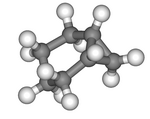This is an old revision of this page, as edited by CheMoBot (talk | contribs) at 16:10, 3 June 2011 (Updating {{chembox}} (no changed fields - updated 'ImageFileL1_Ref', 'UNII_Ref', 'ChEMBL_Ref', 'KEGG_Ref') per Chem/Drugbox validation (report errors or [). The present address (URL) is a permanent link to this revision, which may differ significantly from the current revision.
Revision as of 16:10, 3 June 2011 by CheMoBot (talk | contribs) (Updating {{chembox}} (no changed fields - updated 'ImageFileL1_Ref', 'UNII_Ref', 'ChEMBL_Ref', 'KEGG_Ref') per Chem/Drugbox validation (report errors or [)(diff) ← Previous revision | Latest revision (diff) | Newer revision → (diff)
| |||
| Names | |||
|---|---|---|---|
| IUPAC name Bicycloheptane | |||
| Identifiers | |||
| CAS Number | |||
| 3D model (JSmol) | |||
| ChemSpider | |||
| PubChem CID | |||
| CompTox Dashboard (EPA) | |||
InChI
| |||
SMILES
| |||
| Properties | |||
| Chemical formula | C7H12 | ||
| Molar mass | 96.17 g/mol | ||
| Except where otherwise noted, data are given for materials in their standard state (at 25 °C , 100 kPa).
| |||
Norcarane, or bicycloheptane, is a colorless liquid. It is an organic compound prepared using the Simmons-Smith reaction, by the action of diiodomethane and a zinc-copper couple on cyclohexene in diethyl ether.
References
- Smith, R. D.; Simmons, H. E. "Norcarane". Organic Syntheses
{{cite journal}}: CS1 maint: multiple names: authors list (link); Collected Volumes, vol. 5, p. 855.
This article about a hydrocarbon is a stub. You can help Misplaced Pages by expanding it. |


